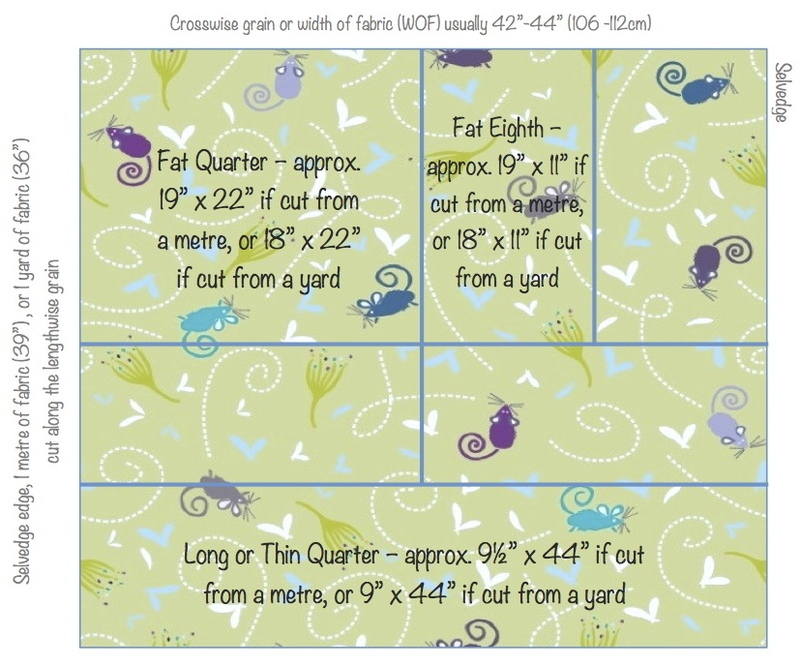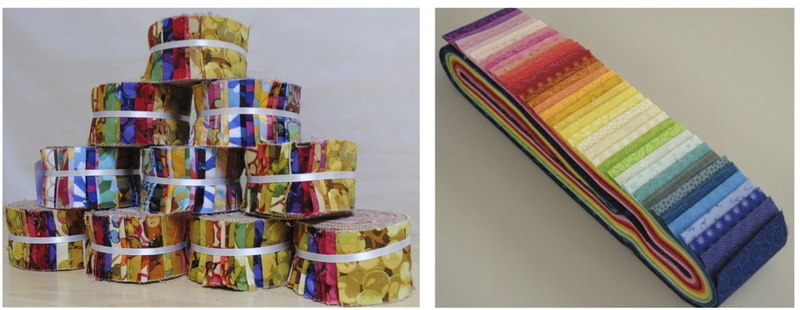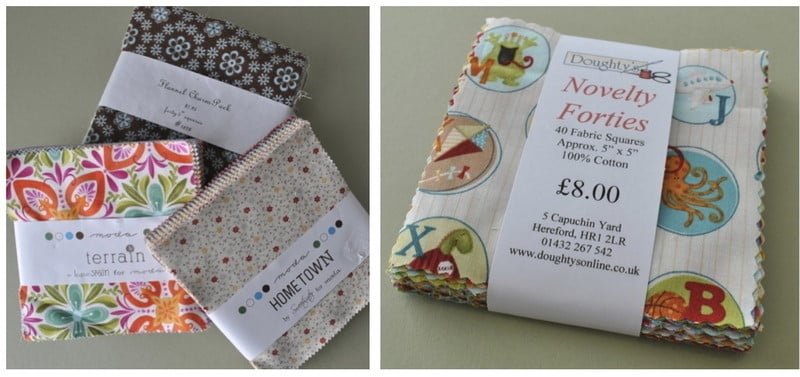Quilting Pre-cuts
Patchwork and quilting is steeped in American tradition and culture, which is why most of the tools, kits and patterns on the market today still use imperial measurements – yards and inches. However, as we are in England, you will find that shops here cut fabric by the metre, which can cause problems when working out fabric requirements for a pattern. Luckily, a metre is just over a yard (10cms more) so if your pattern asks for a yard, and you order a metre, you will have more than enough fabric for your project.
There are a few cutting terms unique to quilting which you will come across in any quilting shop or magazine. In my plan below I have given the measurements for cutting from a metre, as well as cutting from a yard. If you are lucky enough to visit a quilting shop in America, not only will you be overwhelmed by inspiration, but one thing to bare in mind is that their fat quarters and eighths will be smaller than the cuts in England. This also applies to shopping online from US stores. 
When ordering quarter cuts of fabric, some shops, both 'real' and online, may default to Long Quarters (or Thin Quarters). These are cut across the full width of the fabric (44"/112cm) and 25cm down the length. I do hope this chopping back and forth from imperial to metric isn't confusing, but we do tend to say a fabric's width in imperial, and the length to cut in metric! You'll get the hang of it soon!
Long Quarters are ideal for strip piecing, binding, sashing and borders. However, if you want to do some appliqué or want a shape wider than 25cm, then you need a Fat Quarter. These are still quarters of a metre, just cut differently. FQs measure approx. 19" x 22" (50cm x 55cm) and have more surface area than a long quarter. If you are ordering online, and you need FQs for a project but the website doesn't specify their default cut, it may be an idea to phone the shop to check before ordering.
A Fat Eighth is half a Fat Quarter and is ideal for smaller projects such as paper-pieced hexagons, scrappy quilts or appliqué. These are also great for stash building and you can buy more at a time. Do bare in mind though, as these are smaller pieces, (and if you're not into miniature quilts), you may not have enough of one fabric when you come to start a project. Many quilters prefer to buy half metres at a time, funds permitting, to ensure they have enough in their stash when they come to use it.
As well as buying fabric off the bolt, you can also buy fabric packs called pre-cuts. These come in all sorts of shapes and sizes and tend to be made from one entire range of fabrics - this is a great help for us when choosing fabric as we know these will co-ordinate when used in a project together. American company Moda first came up with the Jelly Roll and went on to develop the Charm pack, Layer cake and many more, the copyright of which are all owned by Moda, but look out for similar products from other manufacturers - there are plenty of noodles and strippers out there!
We'll start with the jelly roll...

...an average roll contains forty 2½ x 44" (width of fabric) strips – though bare in mind, not all rolls contain 40 strips – as the jelly roll phenomenon has spread, other companies have brought out their own versions, sometimes with a lot less than 40 strips. These pre-cuts are extremely versatile, from simple strippy quilts, to more complex blocks to even english paper-pieced hexagons. There will be much more about these on the website soon!
Another very useful pre-cut is the Charm Pack...

These are 5inch squares, and again tend to be from an entire range of fabrics that will co-ordinate. These are great for simple quick projects, and especially great for half-square triangle quilts, more on those later!
Other pre-cuts include Layer Cakes - 10" squares, Honey Buns - 1½" strips, Honey Combs - 6" hexagons and then mini versions of all the same. As I've said, these packs are great for beginners, but also used alongside other blenders (co-ordinating fabrics) they serve as a good starting point for any quilter.